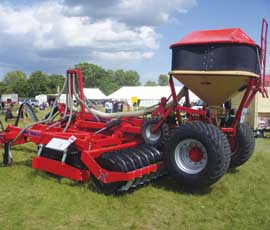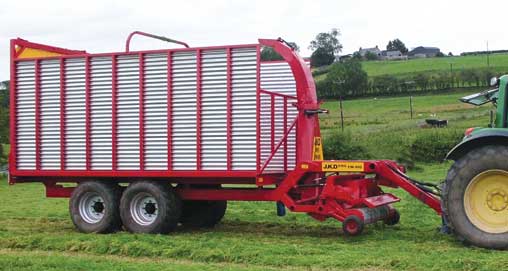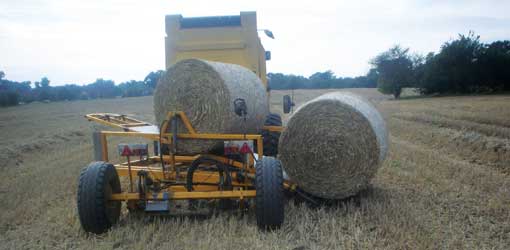Farm inventions comp: Complex category winners

We had nearly 50 entries for this year’s farm inventions competition, ranging from a simple bale carrier to a fully-fledged forage wagon. We round up the winner and runners-up in the Complex category.
WINNER: Andrew Metson’s bean drill
Essex farmer Andrew Metson built this bean drill kit to fit a trailed Sumo Trio. Previously, the farm put beans on with a 6m air drill, then had two tractors ploughing them in and two power harrowing. The results were mixed and there were a lot of blocked seed tubes.
Now one man and one machine can do the job in one pass. A scrap Vicon air drill provided the hopper, metering unit, venturi tube and low-seed indicator while the hydraulic PTO from a Chaviot sprayer drives the fan. Everything else was custom made.
The hopper had to be extended so that it could hold 1.25t. Being fibreglass, the only way to do this was with a ring of stockboard with a flipover tarp for it and a steel ring as reinforcing. The old low-seed sensor was used, but the buzzer no longer worked, so a trailer light cluster and flasher unit were used which flashes on the front of the tank when low.
The hopper is attached to the Sumo chassis by two turnbuckles and quick release hydraulic couplers, with the Sumo’s hydraulics operating the drill. The metering wheel fits between the shoulders of the packer and lifts in and out of work hydraulically with the drawbar ram. When the machine folds, the whole wheel assembly automatically slides towards the centre of the machine to avoid a collision with the packer.
The beans are blown to a distribution head at the front of the machine. As the beans now only go down seven outlets over 4m compared with 32 over the same width on a standard drill, a new distribution head was needed.
The beans then go into coulters made of 50mm (2in) tube that taper into a Sumo leg protector. The coulters are welded on to the back of the legs and are simply ground off at the end of the season. Mounting and dismounting the whole kit takes two people an hour.
The hopper is 6m (20ft) from the distribution head, so it takes a long time for the beans to get to the coulters and they keep coming out for a while after the drill has been lifted out of work. To prevent this, Andrew modified it for this season so the metering wheel works all the time and the beans re-circulate to the hopper on the headland.
RUNNER-UP: James O’Kane’s home-built forage wagon
Most people buy their forage wagons off the shelf, but Magherafelt, NI farmer James O’Kane tackled the job of producing one himself earlier this year. He had used contractors to do his silaging in the past, but felt that some of his land wasn’t suitable for the self-propelled forager his contractor was now using.
The answer was to build his own forage wagon so he could take over the task himself.
It’s a somewhat different beast from anything else on the market, though. For a start, he wanted precision-chop grass rather than the longer chop of most forage wagons.
So, at the front of the machine, there’s the familiar-looking pickup and chopper from a JF900 trailed forage harvester which was given a thorough recondition. A pair of rams lift and lower it – max lift is an impressive 40cm (16in) – and two springs allow it to float.
Behind the chopping unit is a 30cu m (roughly 10t) tipping trailer unit built from scratch. Mr O’Kane says he prefers the speed and mechanical simplicity of this system rather than the relative slowness and complexity of the moving floors used by most off-the-shelf forage wagons. In essence, he just tips and goes.
Construction of the machine took eight to nine weeks (in between other farm jobs) and he was in time to test it on second-cut silage. He’s very pleased with its performance and a neighbouring farmer who borrowed it has said he’d like to buy it. So Mr O’Kane may have to build a second one.
THIRD PRIZE: Paul Hayward’s round bale accumulator
Paul Hayward built this accumulator to go behind a round baler and in front of a Ritchie Traileyre carrier that has been modified to carry 20 round bales.
The first bale is deposited in the accumulator and carried behind the baler until the second bale enters. The pair of bales is then turned through 80˚ and unloaded for collection.
Placing the two bales side by side makes them ideal for collecting with a Ritchie Traileyre or any two-tine conventional loader. This increases the speed of collection and cuts the distance machinery has to travel in the field.
Turning the bales at 80˚ to the tramlines means working with the tramlines rather than across them. This vastly increases speed of collection, says Mr Hayward.
See the winners and runners-up in the Intermediate and Simple categories.



